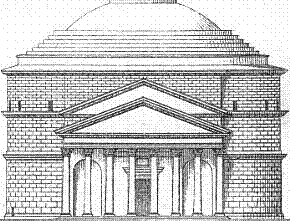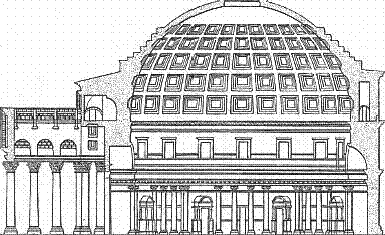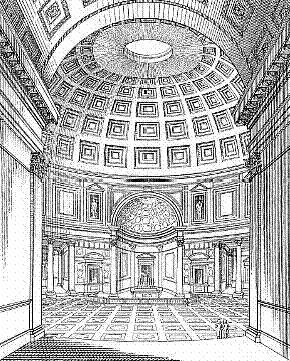chronosomatics | 1997.07.13 | Further Deepening the 'Natural Imagination' |
|
The Natural Imagination
In Wilson's view, the 'artificial imagination' deals with 'abstraction, allusion and manner', while the 'natural imagination' stresses anatomy and the 'energy' of the human figure, thus employing a 'body metaphor'.
But our experience of architecture is far from being encompassed by such learned response and reflection. Indeed in the very first instance quite other responses are at work, a whole array of instinctive reactions triggered by the nervous system and marked above all by the quality of immediacy.
The theory underlying the chronosomatic imagination likewise makes metaphorical use of the body, however, in this case, the 'body metaphor' emanates from human physiology rather than human physicality. In other words, the chronosomatic imagination draws on the body's internal operations and not on the body's figure and external movements.
Similarly Le Corbusier talks about the column as 'a witness of energy' and we are drawn into a world in which remote transpositions of the human figure participate in an exchange of forces, of pressure and release, of balance and counterbalance in which construct and spectator seem to become one.
In the theory of chronosomatics each physiological function, (e.g., fertility, assimilation, metabolism, osmosis, etc.), along with being a distinct corporal operation, also describes a particular mode of the human imagination. The metaphor is simple yet penetrating--the fertile imagination is the most reproductive, the assimilating imagination is extremely absorbent of data, the metabolic imagination simultaneously destroys as it creates, and the osmotic imagination, as we shall see, is the operation (or 'code' or 'chemistry') that produces the 'instinctual reactions' that move Wilson so deeply.
Concepts of psychological 'position'
The basic notions of inside and outside are fundamental to both Wilson's 'Natural Imagination' and to chronosomatic' concept of an osmotic imagination. The main difference between the two theories, however, arises from their respective sources of inspiration. Wilson looks to Adrian Stokes and thus also to psychological interpretations of humanity's relationship with the environment, whereas The Body, The Imagination, and Architecture interpretes the operations of human physiology as the most influential factor behind human imagination.
From Melanie Klein's work on infant psychology Stokes takes the concept of two polar 'positions' or modes of experience through which (it is claimed) we all pass in infancy and against which all our subsequent experience in life is re-enacted. (That the word 'position' with all its connotations of physical space, presence and stance, was chosen to define a psychological state goes a very long way to meet the case that I shall be putting forward.)
"The ultimate place where the molecules of the air of earth come and go is the alveolus. That is far into the lung. That is truly the shore, the border, there where the great outer meets this single inner. 'And he brought them to the border of His sanctuary.' The alveolus is the sanctuary, small, and there are many. Through their walls the gas molecules pass in, pass out. We are unaware of the passing, have usually neither the pleasure nor the unpleasure of our breathing. Someone said that the infant however takes big breaths and feels the air running all through its healthy body, and that this is one of the primal pleasures of life. Possibly that pleasure would have encouraged the infant to expand chest and lungs to the uttermost and thus body and head would appear to have been emerging together, physiology and psychology."
Adrian Stokes points to the significance of the varying combinations by which these two extremes are conveyed to us''4: normally, even in excellent buildings, that one or other of these modes predominates. He then draws an extraordinary conclusion: that it is uniquely the role of the masterpiece to make possible the simultaneous experience of these two polar modes; enjoyment at the same time of intense sensations of being inside and outside, of envelopment and detachment, of oneness and of separateness. A number of other writers have recognised the two poles of experience (Warburg's 'identification' and 'detachment' for instance); Stokes alone[?] perceives the secret to lie in their fusion and upon this rests the originality and significance of his vision. 'In reflecting such combined yet antithetical drives a work of art symbolises the broader integrating processes. This is the unique role of art.'5 (I liken this paradox to the well-known optical phenomenon of Gestalt psychology which claims that it is not possible to register simultaneously both the vase and the kissing profiles. The counter-claim that great art can achieve this 'impossibility' is a criticism of Gestalt Theory.)
The one architectural masterpiece that Wilson does not mention with regard to the 'simultaneous experience of . . . inside and outside' is the Pantheon. This temple, erected by the Emperor Hadrian in Rome, dedicated to all the Gods, and which today is a Roman Catholic Church dedicated to Mary and the remains of countless martyrs brought from the Catacombs in AD 608, not only brings the outside in literally through the open oculus of its dome, but, all the more, brings the entire cosmos inside through its architectural articulations. The Pantheon's interior comprises three horizontally stacked zones. The lower section of the drum corresponds to the earth, the terrestrial, where humanity pays homage to the gods. The attic section of the drum, above the earth and below the dome, is where the gods themselves reside. And the dome, with its moving circle of light shinning through the oculus as the sun and the (former) gilded bronze rosettes within the coffers as the stars, comes to represent the vast universe above.
The Pantheon
a prime example of osmotic architecture
Ward-Perkins says, "With the building of the Pantheon . . . architectural thinking had been turned inside out; and henceforth the concept of interior space as a dominating factor in architectural design was to be an accepted part of the artistic establisment of the capital" A. Boöthius and J. B. Ward-Perkins, Etruscan and Roman Architecture (Harmondsworth and Baltimore, 1970). p. 256. Perhaps we should rather say: Architectural thinking had been turned "outside in!"
One of the most wonderful buildings in the world which conveys its ideas is the Pantheon. The Pantheon is really a world within a world. The client, Hadrian, and the architect, whom I don't know the name of, saw the demand of this pantheonic requirement of no religion, no set ritual, only inspired ritual. He saw the round building, and a very large building. I imagine that he probably thought the building should be at least 300 feet in diameter; he changed his mind because there were no craftsmen who would make such a building, and it was out of the stream of economy. Economy meaning here that there's no man around to do it. I don't mean money--1 don't meanbudget--I mean economy. And so the Pantheon is now a hundred and some feet in diameter. The dome, the first real dome made, was conceived with a window to the sky. Not because of ethereal reasons, but because it's the least distracting, the one that is most transcending. And there is a demand from saying nothing specific, no direction; that's what form says to you, feeling and philosophy. It says no direction to this . . . no oblong . . . a square not satisfying here . . . too far and away at the corners. The round building is something which is irrefutable as an expression of a world within a world.
|
|
3716
| Quondam © 2016.11.20 |



